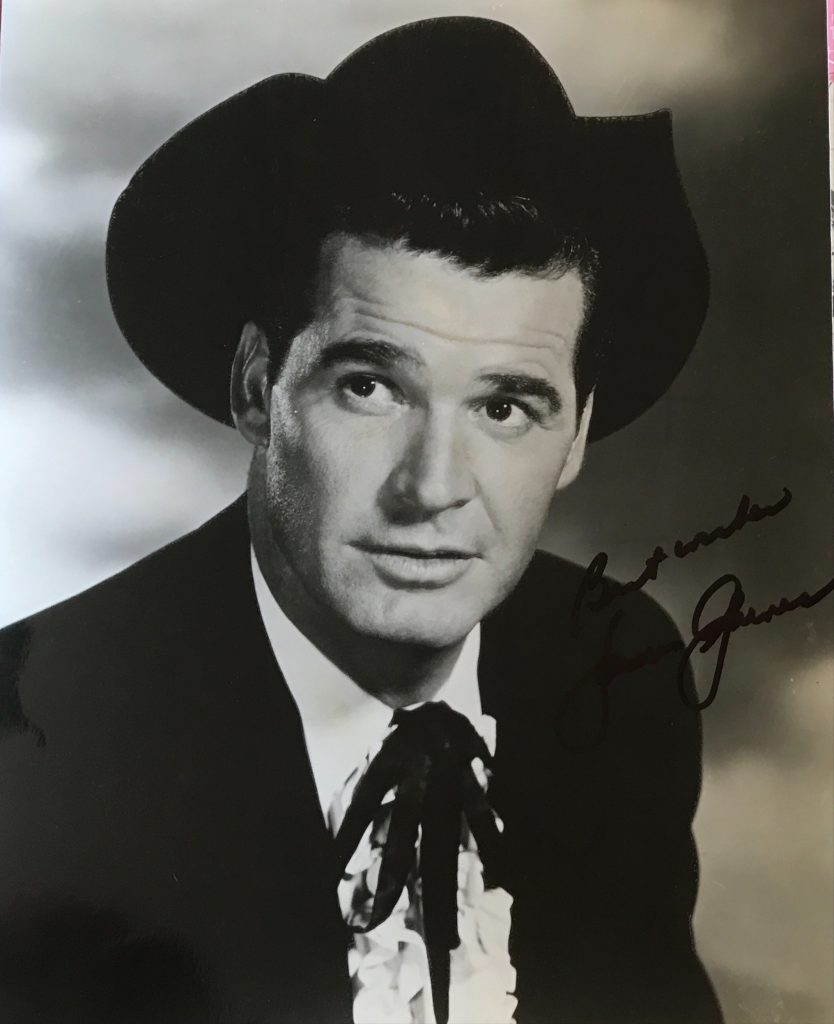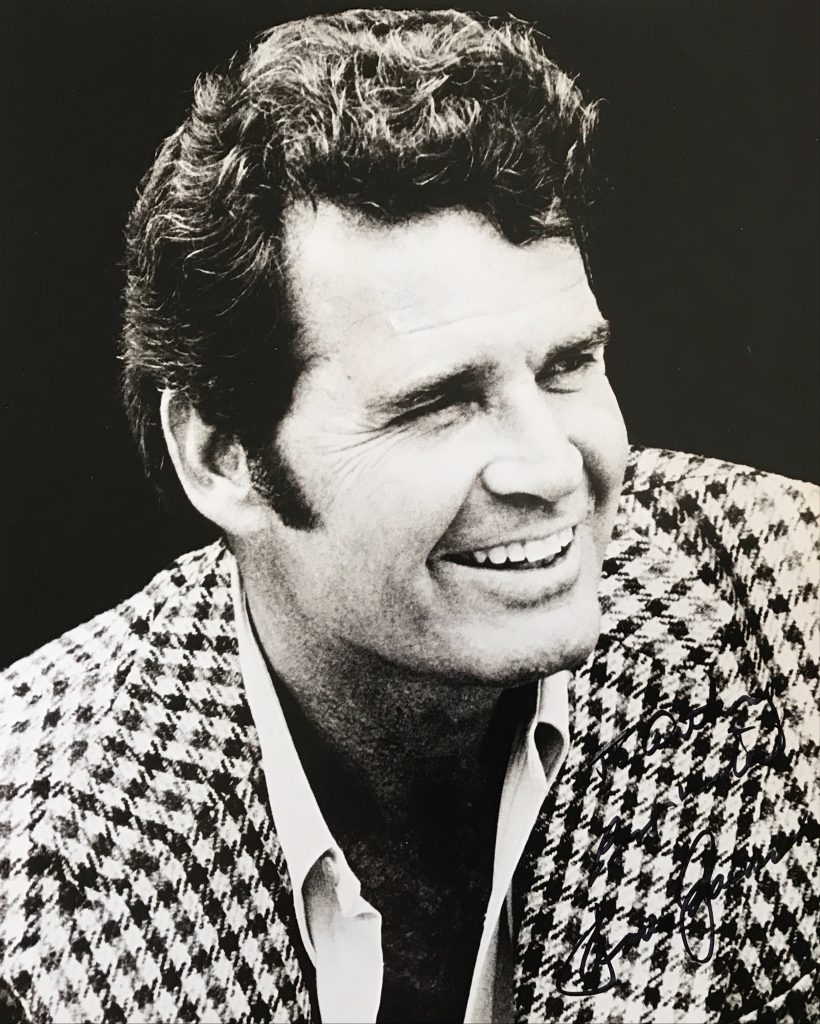
James Garner obituary in “The Guardian” in 2014
Through many films and two influential television series, Maverick and The Rockford Files, James Garner, who has died aged 86, developed a persona with a subtly different appeal. It began as original and accrued familiarity over the course of four decades: a coward who was the soul of honour, a hero likely to ride away, stick his finger up the barrel of his opponent’s gun or get winded in a fight and complain of damage to his dentistry.

When Polaroid cameras commissioned some ads to be shown on American television at the height of its 1970s popularity, it needed a household face, an actor comfortable with the intimacy of the small screen, yet with an edge. Garner was the natural choice.
In 1955, Warner Brothers hired him for small roles in Cheyenne, one of the western series infesting television, and advanced him to Marlon Brando’s buddy in the movie Sayonara (1957). Garner was on contract, on lower television pay rates, when he met Roy Huggins, a writer/producer on Cheyenne, about to script a new show. Huggins shaped it to star Garner, who shared his wry humour, and in his draft pilot, Huggins tried to break as many TV western rules as possible. Garner’s Bret Maverick was to be free of the “irritating perfection” of small-screen cowboys: he would be a greedy, pragmatic conman, for all the charm.
The defining moment, the transition to comedy, happened when the scriptwriter Marion Hargrove added the stage direction: “Maverick looks at him with his beady little eyes.” With that, irony arrived on primetime TV, followed by parody, self-parody, and the theft of any plot or style (including stories by Robert Louis Stevenson and episodes of Dragnet) not actually nailed to the studio floor.
“We nearly killed the cowboy shows,” said Garner. “It was hard after Maverick to see those guys go around being brave without laughing.” Maverick was the hottest show from 1957 to 1959; it reinforced ABC when the network was struggling, and won a 1959 Emmy.Advertisement
In breaks from the series, Garner took leading roles in Warner Brothers feature films, but was still paid only TV rates. When he was suspended in 1960 during a writers’ strike, he walked off Maverick and out of his contract (“contracts are one-sided affairs; if you click, the studio owns you.”) He sued Warners for breach: Warners claimed that the strike was beyond its control, but the court was told that the studio had got 100 scripts under the table and had 14 writers working under the pseudonym W Hermanos (Spanish for brothers). The judge found for Garner.
Released – he thought for ever – from his gambling man’s fancy waistcoat, Garner became a box-office name; he was at his most interesting – the smile cold, or on hold – in two second world war films, the sober comedy The Americanisation of Emily (1964), and a psychological thriller, 36 Hours (1965). In other comedies he took the sort of roles that might have gone to Rock Hudson, but with sharper moves and delivery (The Wheeler Dealers, 1963). His identity as a natural fixer was important to The Great Escape (also 1963) – he drew on his Korean war memories of being the company scrounger.
The films that determined the rest of his long working life were made as his big screen career declined, after he realised that he needed his own company – Cherokee Productions – to control material. They were Support Your Local Sheriff! (1969, followed by the less fresh 1971 Support Your Local Gunfighter), in which he developed his contrary hero: “I make no secret,” his drifter drawled, unimpressed by the wildness, or indeed the westernness, of a frontier town, “of the fact that I’m on my way to Australia.”
His other crucial movie was Marlowe (1969), an adaptation of Raymond Chandler’s private-eye novel The Little Sister. The script wasn’t vintage noir – there was a martial arts scene – and Garner was not exactly Chandler’s Philip Marlowe, but he was droll and melancholy. Garner returned to TV in 1971 (Cherokee Productions partnering Warner Bros), with Nichols, a western set in 1914, harder and more elegiac than TV had tried before; his Arizona sheriff rode a motorbike. It was Garner’s favourite series, but it had low ratings and was soon withdrawn.
His second breakthrough came in 1974, when Huggins still in the business, assigned a pilot script to the writer Stephen J Cannell, who decided to break as many rules of the TV private-eye genre as he could. The obvious casting was Garner: Jim Rockford, the ex-prisoner hero of The Rockford Files, was a downmarket Marlowe, with no office but his mobile home at the beach, an answering machine instead of a secretary. His gun was stored in the biscuit jar. Rockford had a paunch from tacos and beers; he was lazy; and, except for his retired trucker dad, he knew mostly bums, losers and put-upon LAPD cops.
As Maverick had done, the series pushed the televisually possible further. Storylines could be serious – Garner was proud of an episode based on a New Yorker investigation into the grand jury system, so acute that it helped change the law. But it was the sense of a weird Los Angeles, sundried as a lizard up canyon roads, that was new and different. Critics panned it, but the first season was a ratings hit; then Huggins was pushed out, and Garner confronted Universal Television over an enforced change in tone. Rockford lost 20% of its audience but continued for five seasons (Garner won his Emmy in 1977); then it ended suddenly in the sixth season, when Garner told the crew on location that he was exhausted and had no intention of dying early, and walked out.
Universal sued for breach of contract; Garner countered with a $22.5m suit; Universal settled years later for an undisclosed multimillion sum. After the 118 episodes of the original run (1974-80), there were some TV reunion films in the 1990s. Garner was at a loss for a project, and “leerily, because I don’t think you can beat nostalgia” he agreed to revive Maverick for NBC, acknowledging time by making Bret owner of a saloon – “when you get older you’re not out there shootin’ and ridin’ and carryin’ on with the Indians”. But “the westerns had been dead for a long time – we didn’t have anything to poke fun at”; the show’s audience was too old to appeal to advertisers. It was cancelled.
He made occasional movies, unfazed by a cross-dressing Julie Andrews in Victor Victoria (1982), and in facing his age in Murphy’s Romance (1985), his Oscar nomination. He had one more try at series TV, in 1991, in a half-hour comedy Man of the People – a conman in elected office – but it was cancelled midseason.
Garner was never snobby about TV and he began to use mini-series not as a pension, but as a chance to do offbeat material. There were proper notices and Emmy nominations for Heartsounds (1984), where he was a doctor accepting death – his own; he played a corporate executive in the takeover drama Barbarians at the Gate (1993), HBO’s early attempt to use its cable freedom to create tough work.
Just how skilled was his projection of ease could be seen in the movie incarnation of Maverick (1994) – Mel Gibson played Bret, and Garner Bret’s pappy. Relaxing in a bath with a cigar, he stole the film – he did the same to Clint Eastwood in Space Cowboys (2000), and he had done it to Bruce Willis in Sunset (1988) playing Wyatt Earp, an aged consultant to silent movies. That was his second Earp: his humourless portrayal in Hour of the Gun (1967) was against the run of his usual persona.
The Notebook (2004) showed his capacity for veteran romance, with Gena Rowlands. And he continued on TV, most suitably as that voice of American tale-telling, Mark Twain, in Roughing It (2002). As David Thomson wrote, on TV Garner delivered good-natured wit an hour a week for so long over the decades that “If a screen actor did that, he’d be Cary Grant”.
The name of Garner’s production company reflected the fact that his mother, Mildred, was part-Cherokee; he was born in Norman, Oklahoma, and she died when he was four. His father, Bill, ran a hardware store. Seasickness made the Merchant Marine hard going for him, but Korean war service brought him two Purple Hearts. His first stage experience came in bit parts touring in The Caine Mutiny Court Martial.
In 1956, he married Lois Clark. She survives him, as do his daughter Gigi and stepdaughter Kimberly.


